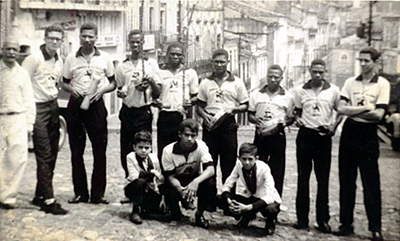1. Brazil’s name comes from a tree
Brazil’s original name was Ilha de Vera Cruz (Island of the True Cross) – given by the explorer Pedro Alvares Cabral when he landed in Brazil in 1500. When they figured out Brazil wasn’t an island, they changed it to Terra de Santa Cruz (Land of the Holy Cross).
The first commercial export of the new land was brazilwood (pau-brasil in Portuguese). “Brasil” comes from the Portuguese word brasa (ember), because the wood has a red color and can be used to make red dye. The inhabitants of this new land came known as brasileiros – that is, people who work in the harvest of brazilwood. And brasileiro is the word for Brazilian to this day!
Bonus Fact: Brazilwood is commonly used to make violin/cello bows. Just look at that handsome color!
2. The colors of the Brazilian flag originally represented European nobility
Dom Pedro I, the first ruler of the Brazilian empire, decreed in 1822 that the Brazilian flag would be green with a yellow diamond, with the imperial crest in the middle flanked by branches of coffee and tobacco to represent the country’s wealth. It looked like this:
The green and yellow represented the dynasties of Braganza (which Dom Pedro I belonged to) and Habsburg (which his wife belonged to).
When Brazil was proclaimed a Republic in 1889, a temporary flag was used for four days. It looked like this:
On November 19, 1822, the modern Brazilian flag was adopted in more or less the design it has today. It is now believed that the green represents the forest, the yellow represents Brazil’s mineral wealth, and the blue represents the sky.
Bonus Fact: The stars are actually in constellations and depict the night sky over Rio de Janeiro on the night the Republic was declared. Also, each star stands for a specific Brazilian state.
3. Over 200 languages exist in Brazil
…and there used to be many more; it is estimated that around 75% of the indigenous languages that once existed in Brazil have become extinct. Of the ones that remain, 42 are considered practically extinct and 91 are at high risk, being spoken by fewer than 100 people.
The languages that still have a reasonably strong presence are:
- Creole: 25,000 speakers in Amapá
- Caingangue: 18,000 speakers in seven states
- Caiwá: 15,000 speakers in Mato Grosso do Sul
- Terêna: 15,000 speakers in the interior of Mato Grosso do Sul
- Ticuana: 12,000 speakers in the north of Amazônia
- Guaraní: 5,000 speakers in the central-west of Paraná
4. Brazil’s capital city was built within less than 4 years
Brazil’s first capital was Salvador (1549-1763) followed by Rio de Janeiro (1763-1960).
The idea to move the capital inland goes back to 1761, when the prime minister of Portugal at the time wanted to move the capital of the Portuguese empire to the interior of the Brazil colony. The idea eventually gained steam, and in the first constitution of the Republic of Brazil in 1891 there was a decree to move the capital from Rio to a more central location.
President Juscelino Kubitschek ordered construction to begin in 1956, and Brasilia was officially inaugurated in 1960. It was projected to have a population of 600,000 by the year 2000, but the population exploded – today, it’s home to about 2.5 million and is the 4th largest city in Brazil.
Bonus Fact: From the air, Brasilia looks like an airplane. Can you see it?

5. Brazilians believe they invented the airplane
 Alberto Santos-Dumont is considered “the Father of Aviation” in Brazil, and many Brazilians believe it to be a great injustice that he is not credited with the invention of the airplane.
Alberto Santos-Dumont is considered “the Father of Aviation” in Brazil, and many Brazilians believe it to be a great injustice that he is not credited with the invention of the airplane.
Santos-Dumont made his first flight in a fixed-wing airplane in Paris in 1906. The news exploded in Europe and Santos-Dumont’s flight was recognized and certified by the Fédération Aéronautique Internationale.
…but then the American Wright brothers came forward and claimed they had beaten Santos-Dumont by three years, with their 1903 Kitty Hawk flight.
Brazilians say the Wright brothers’ flight “didn’t count” because:
- They used a catapult and rails to launch the plane, whereas Santos-Dumont’s plane had wheels.
- Kitty Hawk has strong headwinds that helped their plane get off the ground, whereas Santos-Dumont’s plane took off on its own power.
Bonus Fact #1: The Wright brothers version is apparently not taught in Brazilian history textbooks.
Bonus Fact #2: Santos-Dumont was one of the first men to use a wristwatch (as opposed to a pocket watch), as it was easier for him to check the time while keeping both hands on the controls.
…………………………………………………………………….
Which of the five facts surprised you the most?
Leave a comment with your answer!







